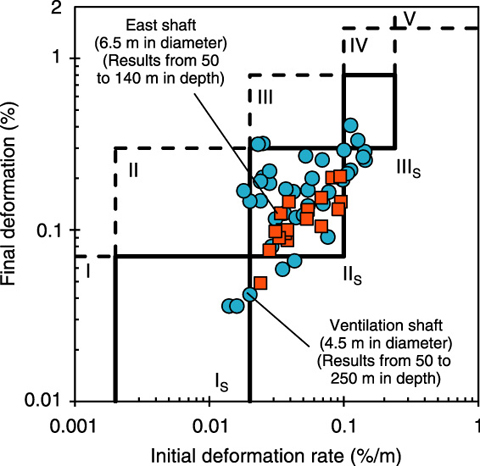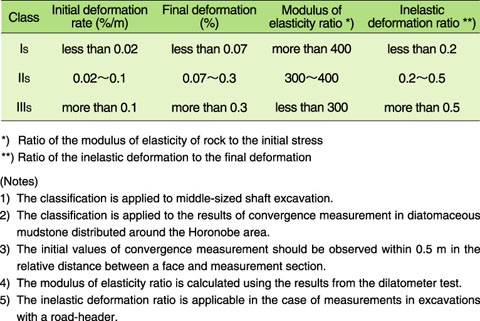
Fig.2-17 Relationship between initial deformation rate and final deformation observed in shaft sinking at the Horonobe URL
Table 2-2 Rock mass behavior classification for deep shaft sinking

In deep underground tunneling, it is difficult to properly estimate rock mass properties and the initial stress conditions on the basis of a surface-based investigation. The quantity of support elements in the design phase should be modified at the construction phase based on the results of observation of rock mass properties in the excavation face and monitoring of rock deformation. The mechanical stability of support elements and rock around a tunnel are usually estimated based on monitoring of the deformation caused by excavation work. The total deformation which occurs until rock stabilizes (the final deformation) is predicted based on the deformation observed in the earlier excavation steps (the initial deformation rate). In tunneling in deep geological disposal sites, control over changes in the hydraulic conductivity of rock around a tunnel is required so that the rock can function as a natural barrier. Specifically, in the construction phase, a practical guide would be needed to predict and estimate not only the stability of the rock but also changes in the hydraulic conductivity of the rock around a tunnel based on monitoring of rock deformation.
In this study, at the Horonobe URL, we investigated the relationship between rock deformation and rock mass deformability during the sinking of the ventilation shaft (4.5 m in diameter) and the east shaft (6.5 m in diameter). It was found that rock deformation was controlled well compared with conventional tunneling, because the rock around a shaft was supported by a 400 mm thick concrete lining installed in the early stages of excavation. Based on the indexes used in conventional tunneling in rock, we proposed a relationship between the initial deformation rate and the final deformation in shafts sunk at the URL. It consists of 3 classes (Class IS, Class IIS, and Class IIIS) (Fig.2-17). To a significant extent, changes in the hydraulic conductivity of rock around a shaft are caused by inelastic deformation of the rock. We analyzed the relationship between the ratio of inelastic deformation to final deformation and rock mass deformability in each class. The relationship is shown in Table 2-2 as a rock mass behavior classification in shaft sinking. The classification helps us estimate excessive inelastic deformation of rock based on monitoring of rock deformation conducted in the earlier stages of excavation, and to make decisions on the installation of additional support elements. We establish a practical guide for shaft sinking in deep geological disposal sites by analyzing the relationship between the inelastic deformation of rock and the hydraulic conductivity of rock around a tunnel.